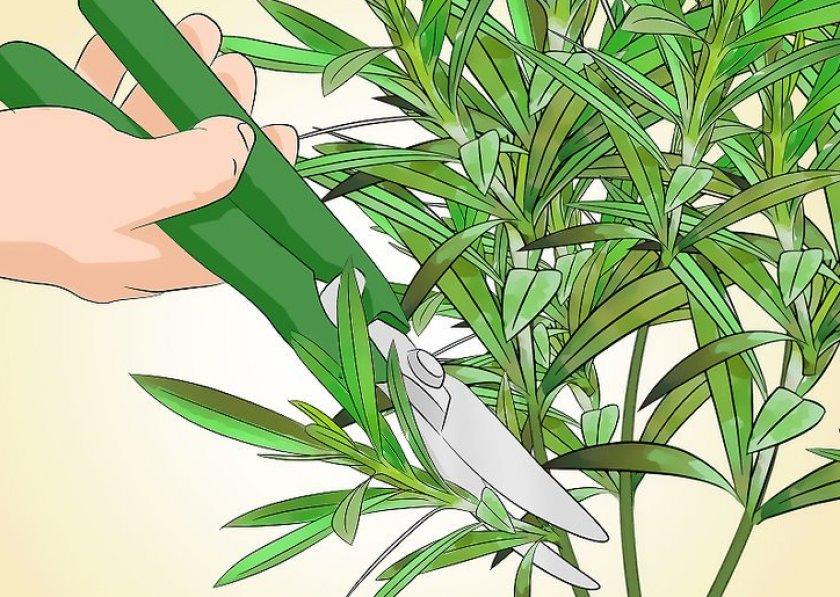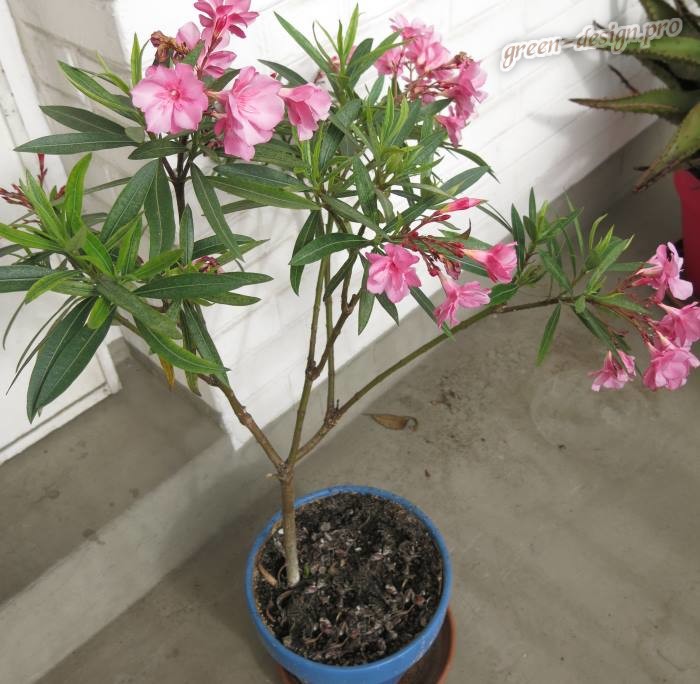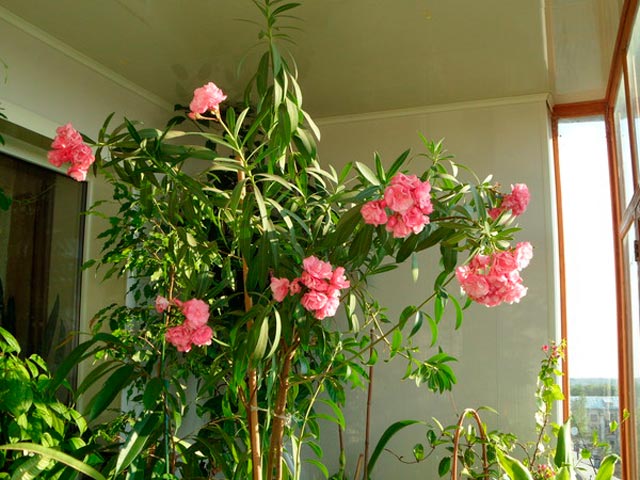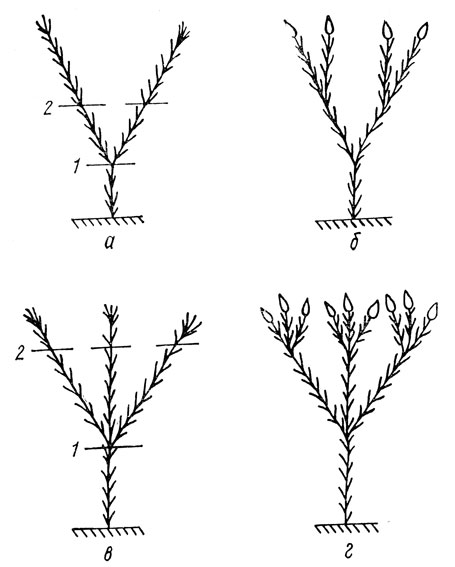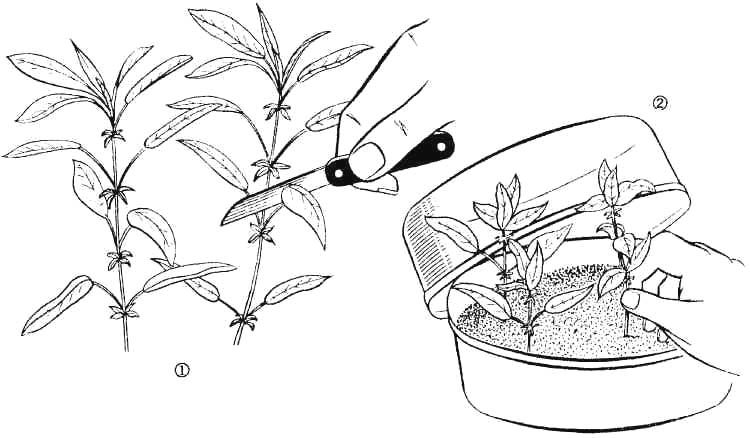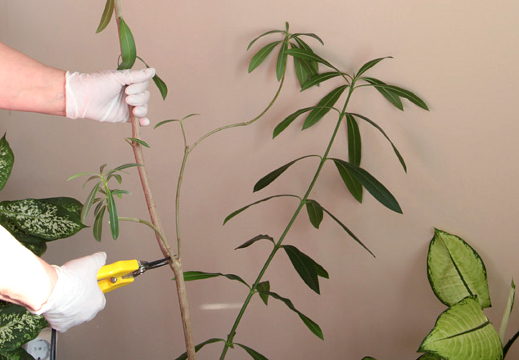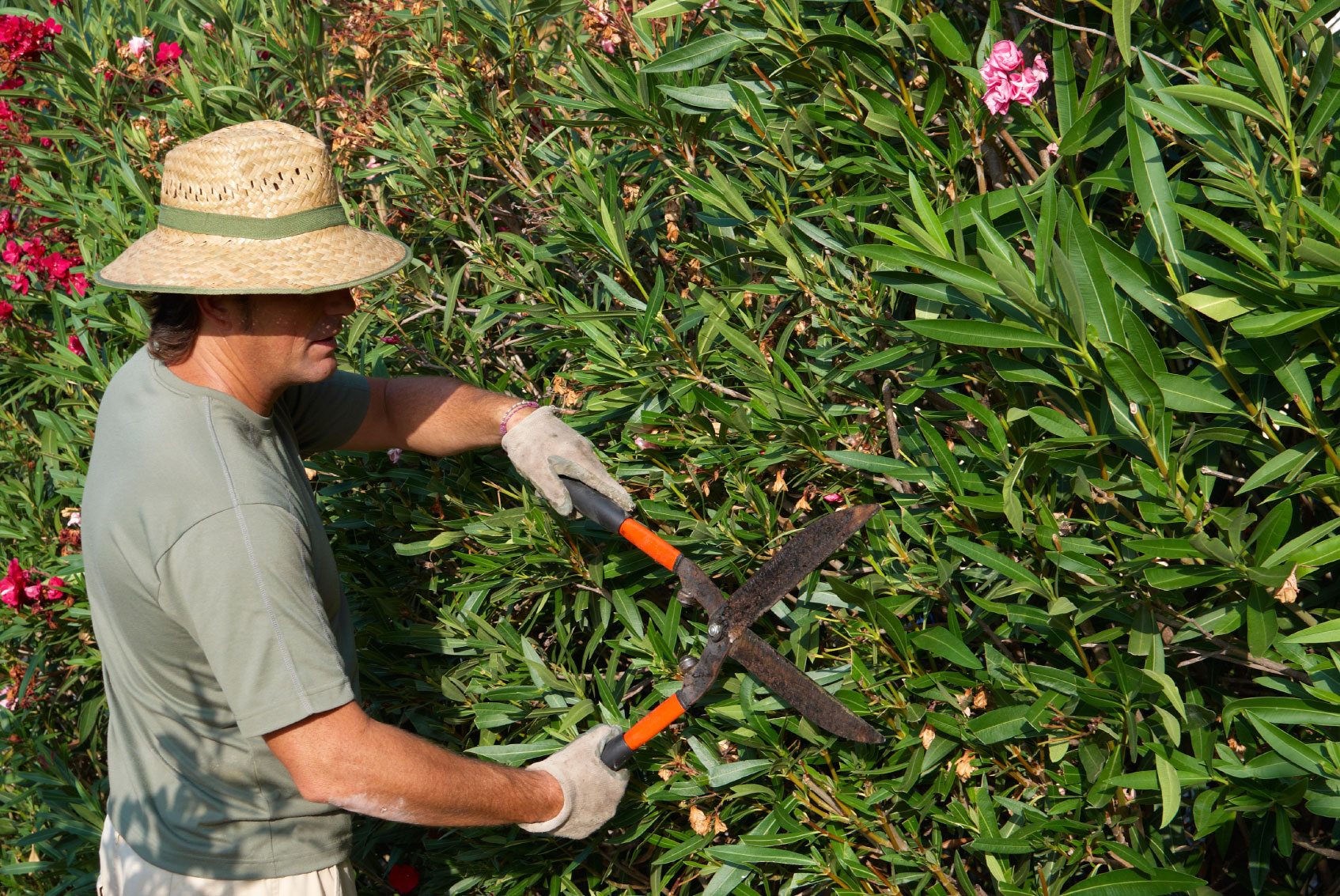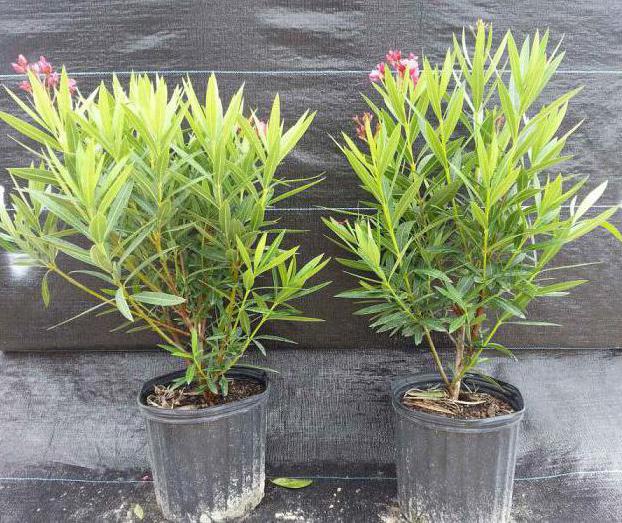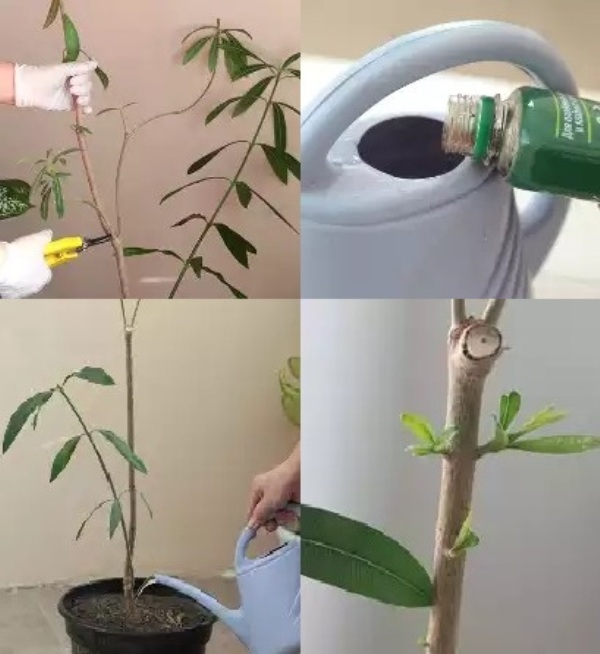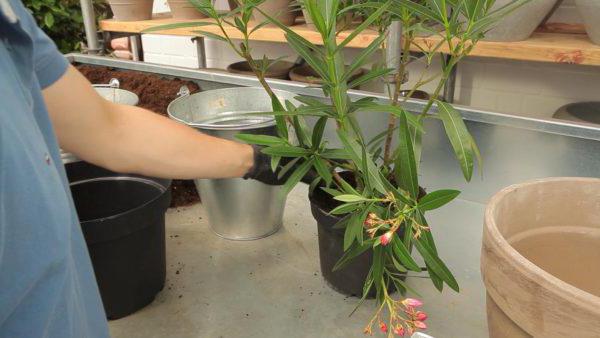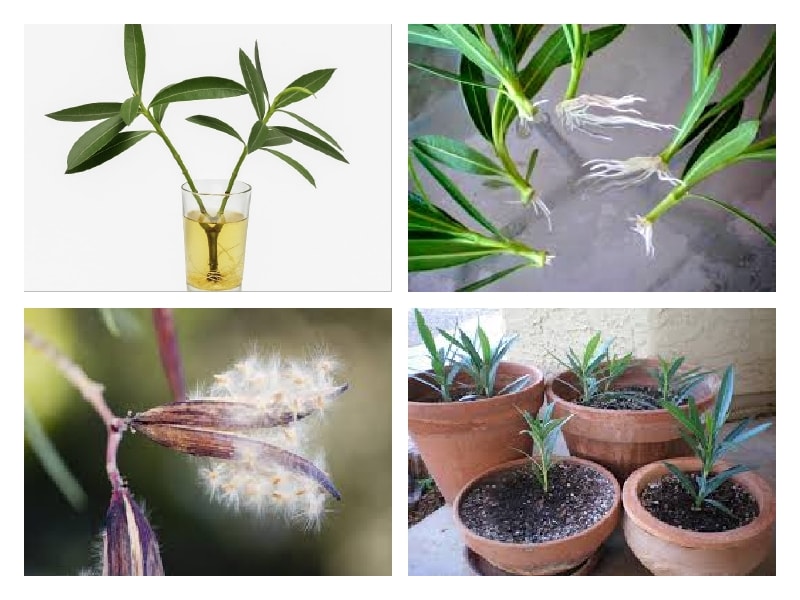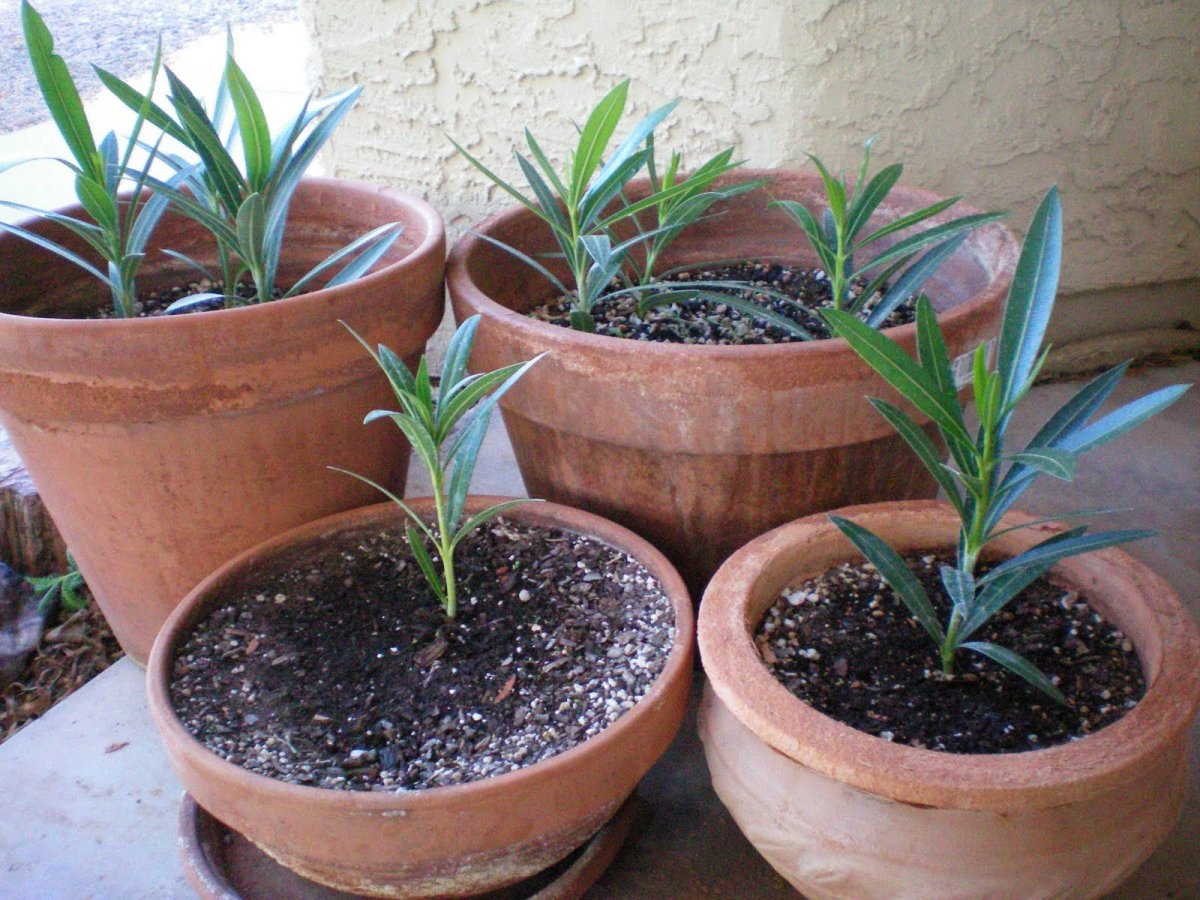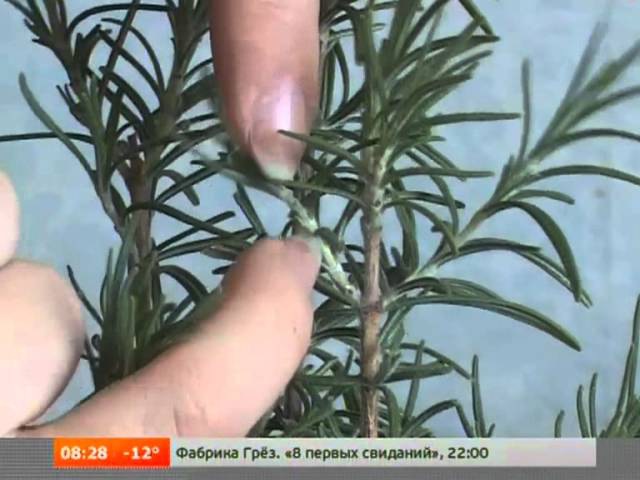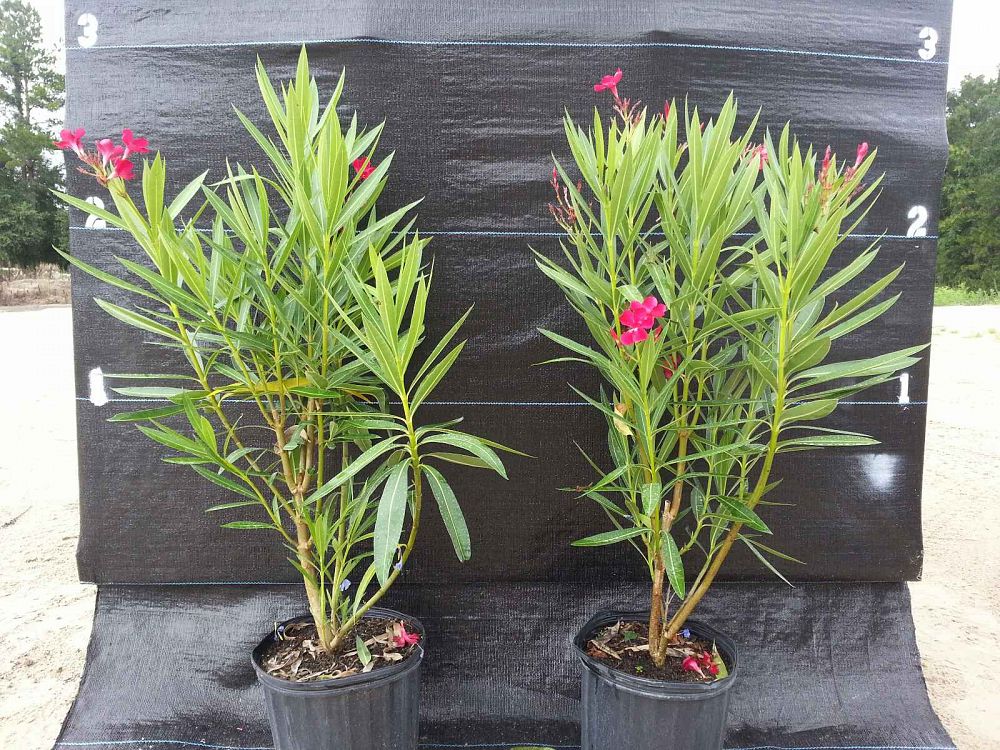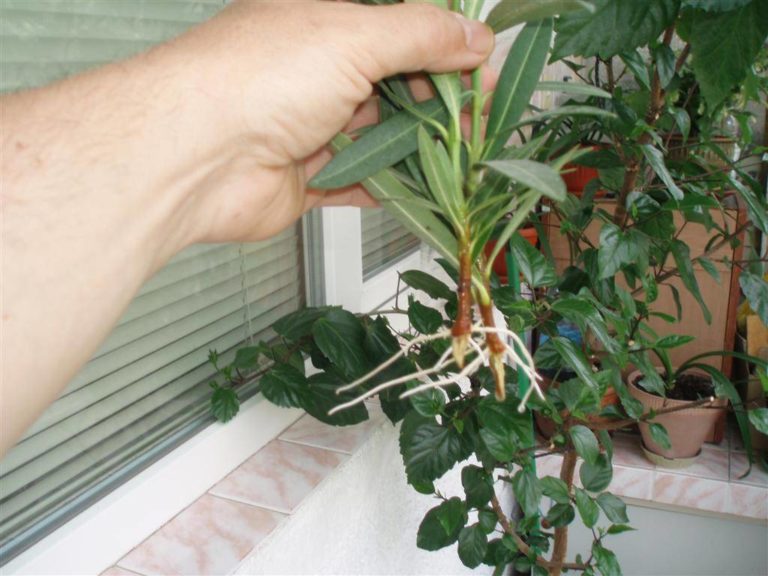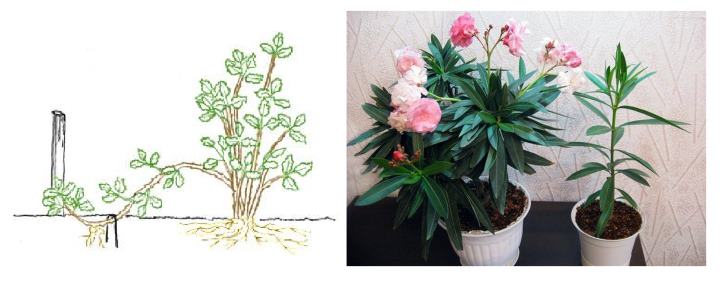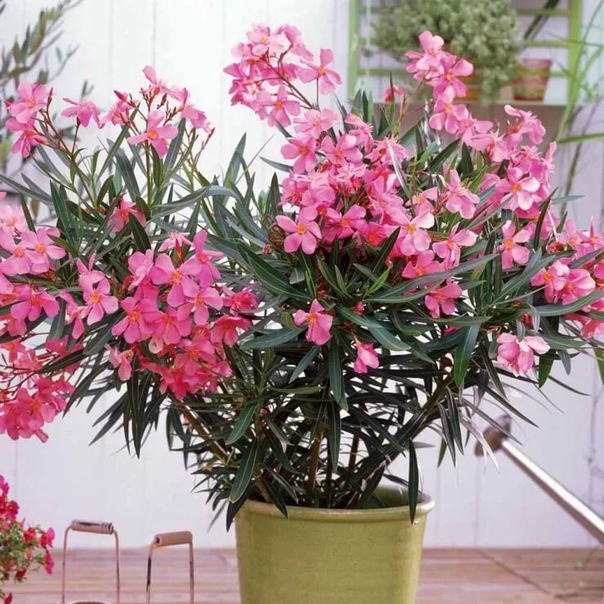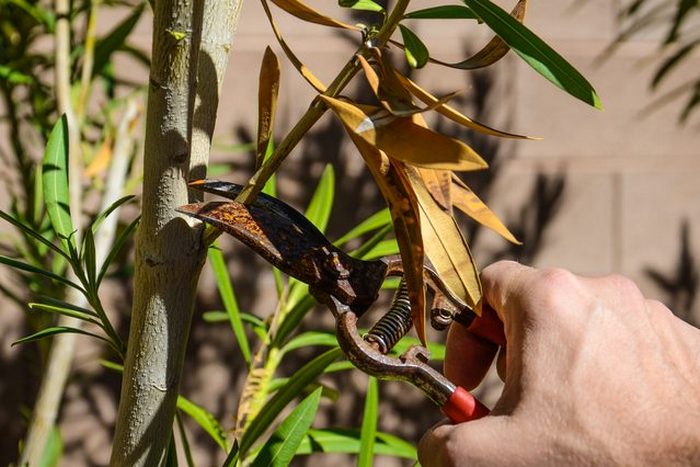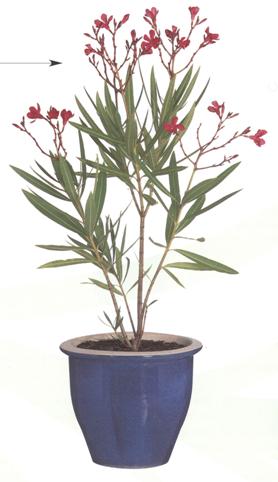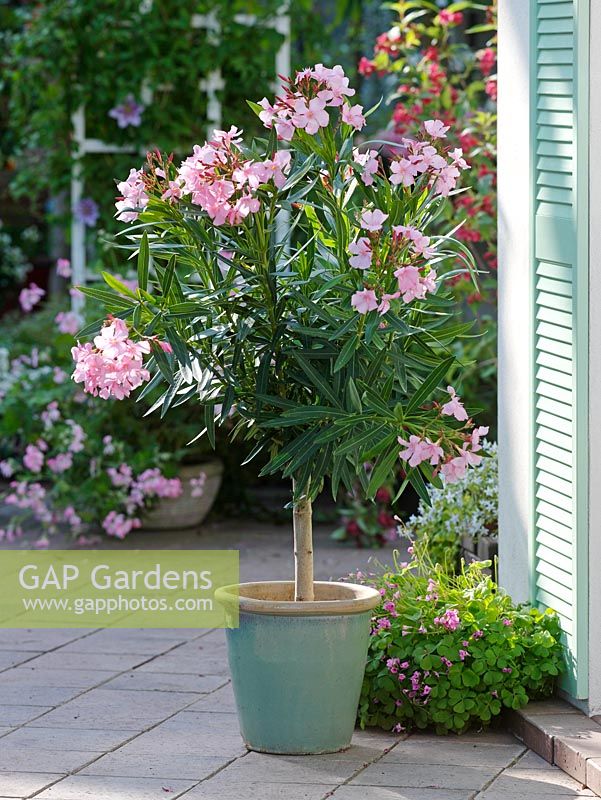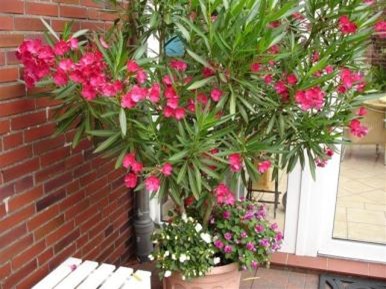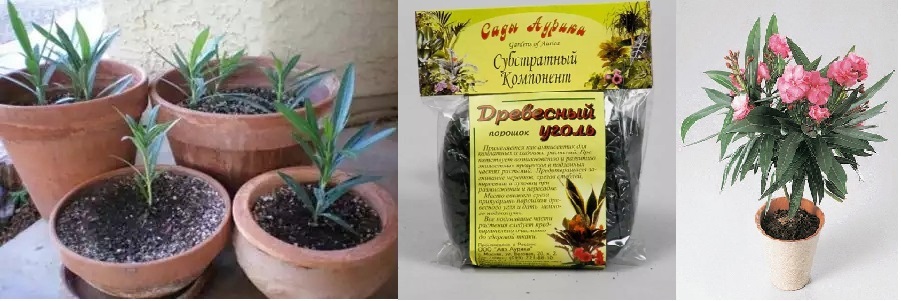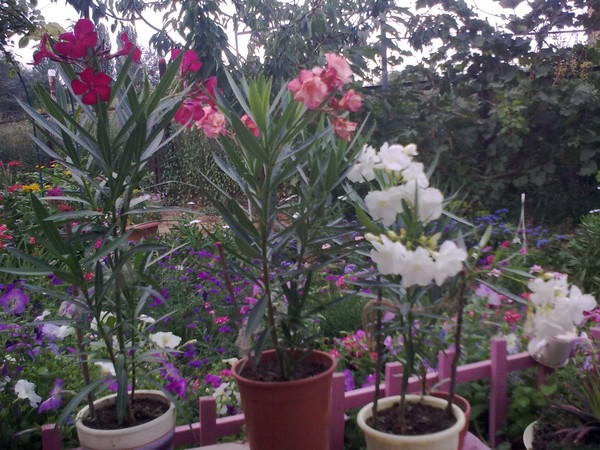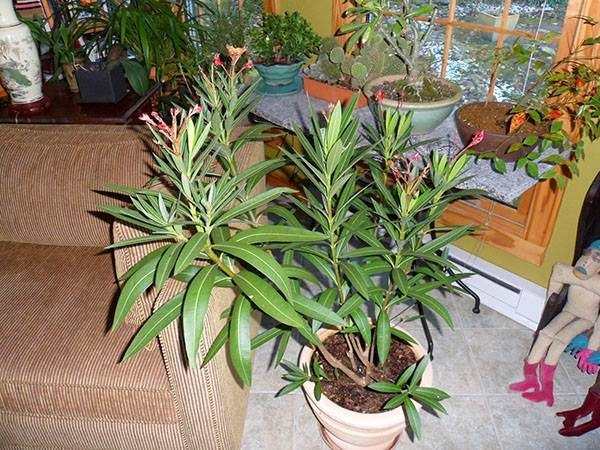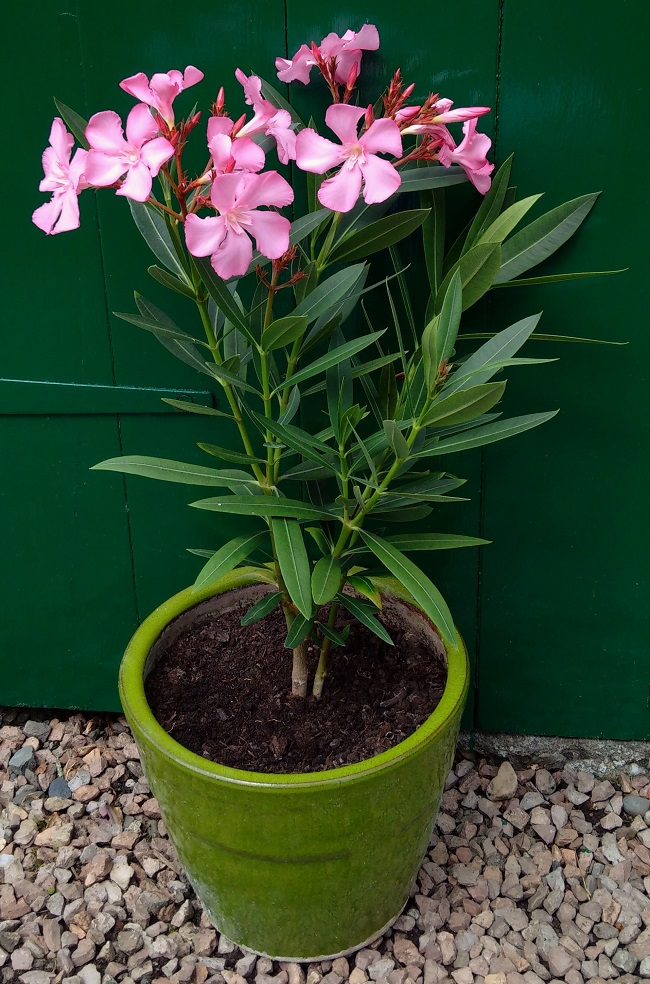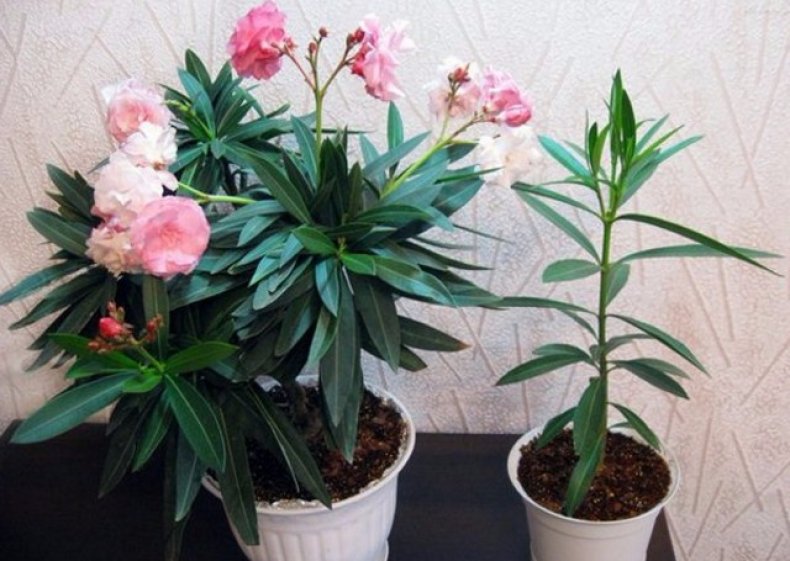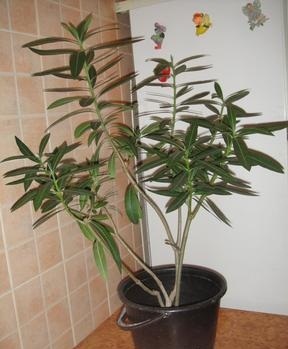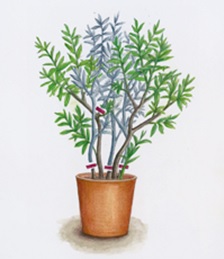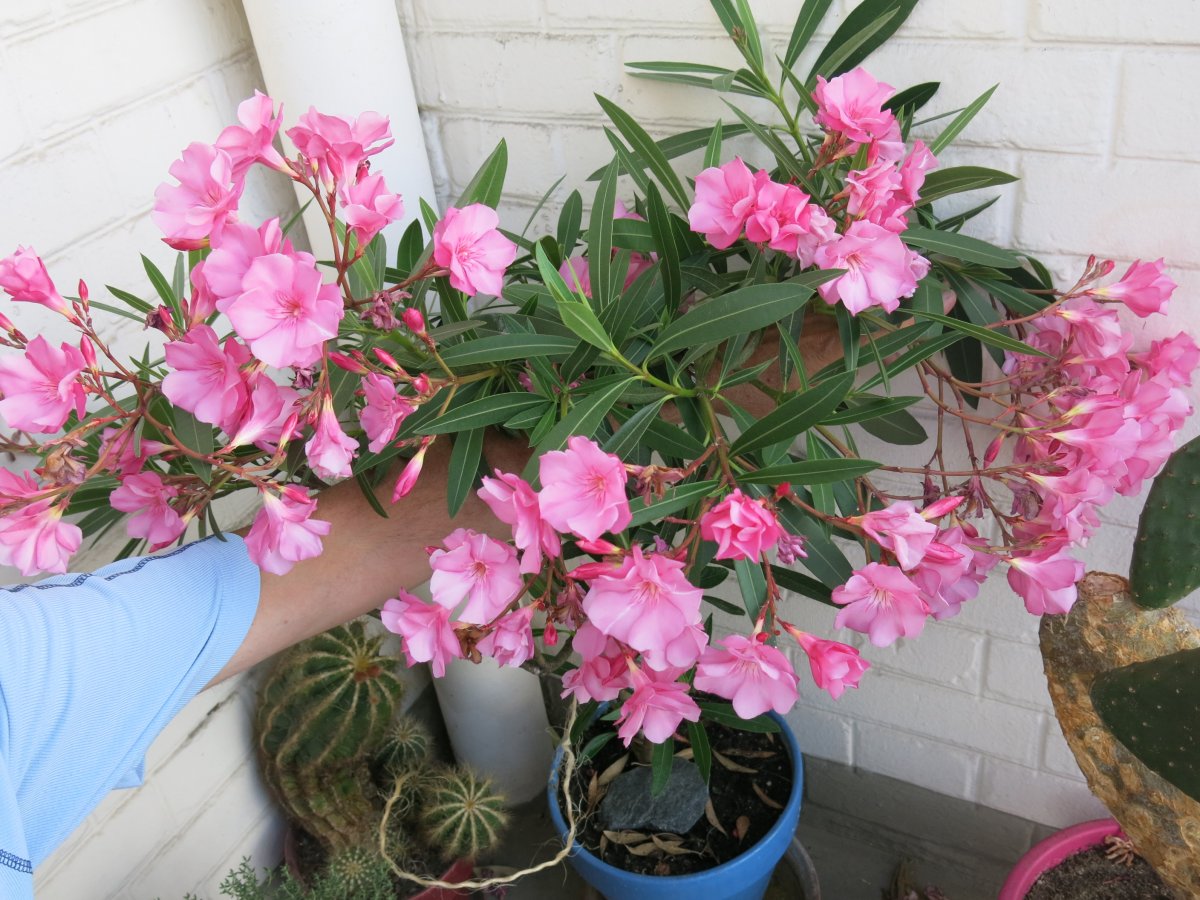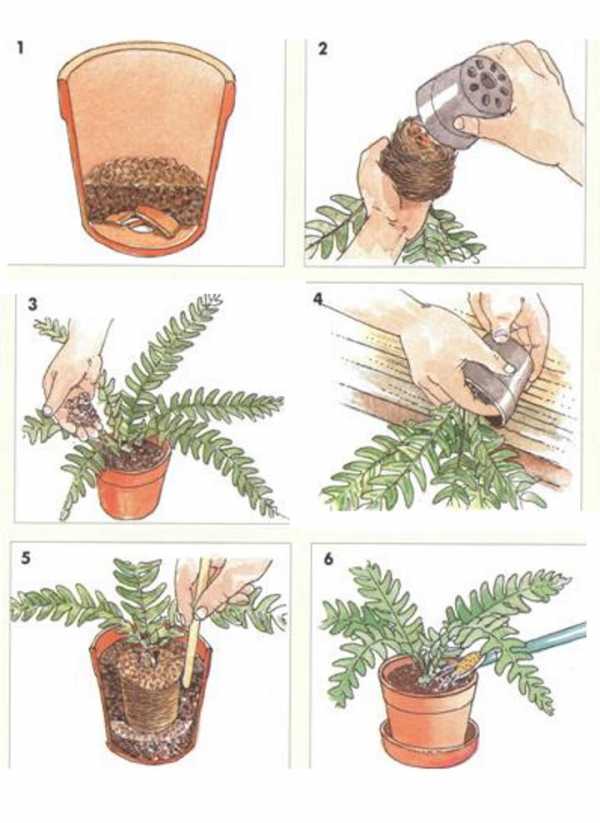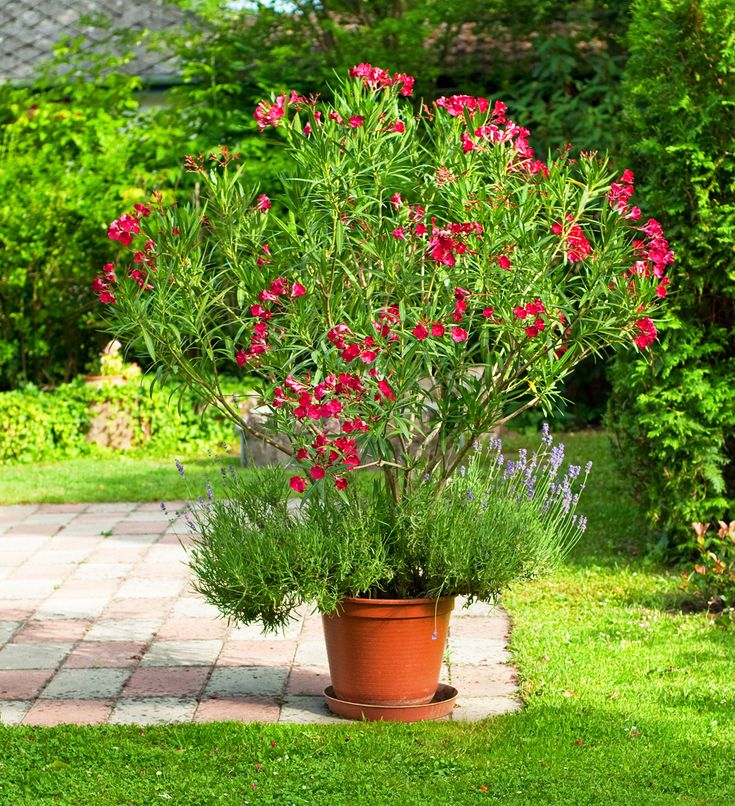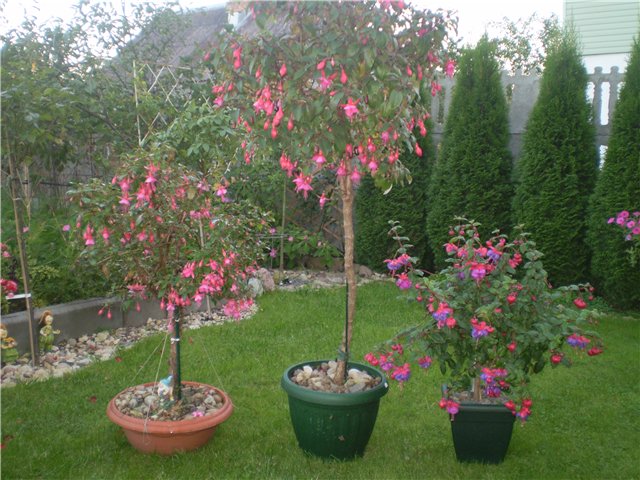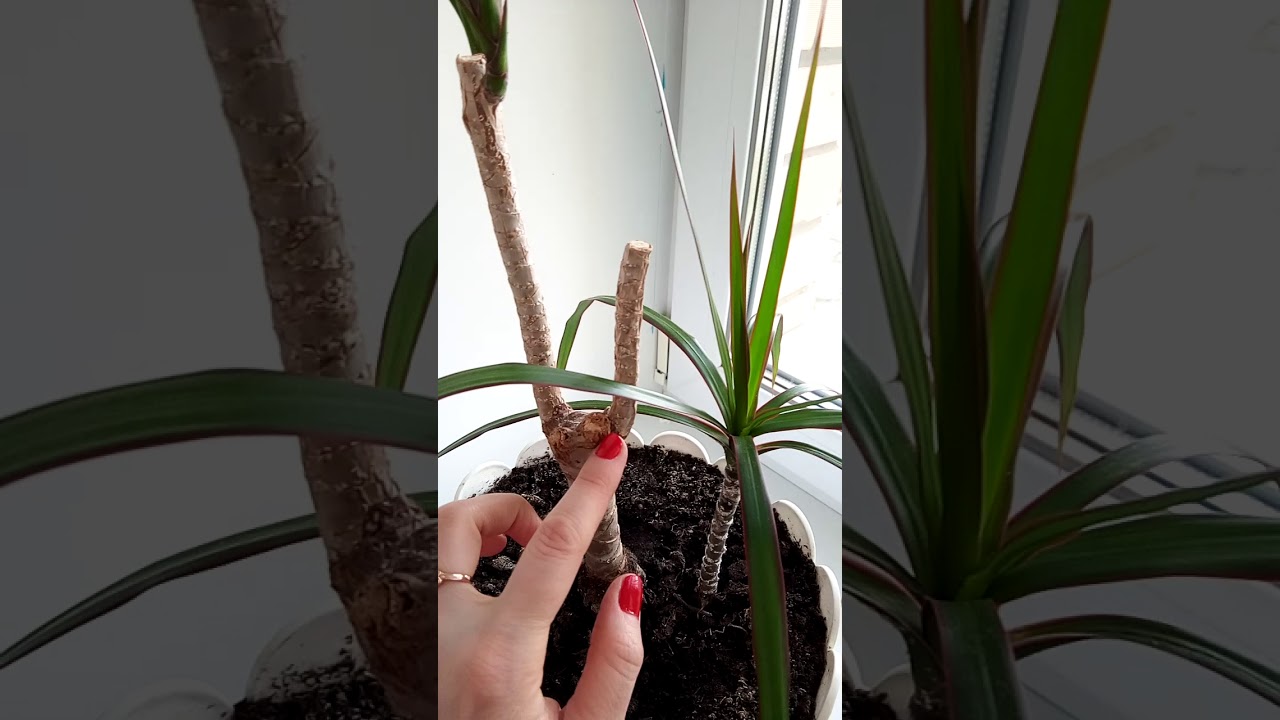Features of keeping oleander at home
With proper care, feeding and crown formation, oleander pleases with lush flowering for a long time. The southern plant is very fond of sunlight, so arrange it on a light, preferably southern, window. It is possible not to arrange a flower pot on the windowsill, but the distance to the window should be small, no more than half a meter. If there is little light for the flower, it will begin to stretch upward, the same happens when there is a deficiency of nitrogen in the dressing. The home flower is quite unpretentious, you will be able to grow a large bush if you transplant it in time and form a crown when pruning. It is advisable to grow the Flower in a tub in the fresh air, for example, on the balcony, and bring it into the house in the fall.
The main feature of oleanders is toxicity, though not as dangerous as people think. Indeed, toxic substances - glycosides are present, but an adult is unlikely to want to eat a hard leathery leaf or a piece of bark of a house flower. But if children and animals live in the house, you should not risk it.
The plant has a rich, pleasant smell, but what pleases in the fresh air can cause a headache in a cramped room.
Flowering time occurs in the summer months, when the windows are almost always open, but it is better not to settle this houseplant in the bedrooms.
Reproduction of oleander
The plant propagates by cuttings, seeds and layering. The first two methods are the most common.
Cuttings
The easiest way to propagate oleander is by cuttings left after pruning. They are cut up to 15 cm long. To protect against decay, the slices must be treated with chopped charcoal and dried. Charcoal is also poured into the ground prepared for rooting. After planting in the ground, the root collars are sprinkled with sand so that rot does not appear. The pot should be kept in a well-lit place; it is undesirable to water the soil.

Rooting cuttings
If the cuttings need to be rooted in water, then the liquid is also disinfected with charcoal. In water, the first roots appear faster, after about a month. Then the cuttings are planted in pots with a prepared soil mixture. You need to propagate cuttings in a bright, warm room.
Growing from seeds
Growing nerium oleander from seeds is a more difficult and rare breeding method. Not all seeds have good germination; the process requires a certain temperature regime and backlighting. In addition, seedlings may lose varietal characteristics.
Before planting, freshly harvested seeds are soaked for half an hour in a weak solution of potassium permanganate or fungicide. Then it is kept in a solution of Heteroauxin or Zircon for an hour. Prepare an earthen mixture as for an adult plant and sow the treated seeds.
For oleander seedlings, care should be most favorable:
- backlighting with artificial light;
- airing the room;
- optimal temperature and humid air;
- regular watering.
Note! The seeds hatch within two weeks. After the appearance of 4-5 leaves, nerium oleander sprouts are seated in separate containers
Growing at home
Among flower growers, oleander is considered an unpretentious plant, the cultivation of which is available even to a novice amateur. Caring for oleander at home comes down to a simple set of sequential actions. But in order to grow a tall, spreading, abundantly flowering bush of this beautiful plant, a number of important conditions must be met. Otherwise, the oleander will not fully reveal its decorative potential and will not show all its amazing beauty.But this plant is considered one of the most beautiful shrubs grown at home.
Required climate
The homeland of oleander is the southern subtropics, so he is very fond of the abundance of sun, heat and moisture. Prefers loose, sandy loam, neutral acidity soils. Loves periodic spraying and the presence of a constant source of moisture in the neighborhood, for example, an aquarium with fish. At the same time, it does not tolerate chronic waterlogging of the soil, preferring watering rare, but abundant and deep, rather than frequent and superficial. The basic requirements for home growing are as follows:
- Location. A large room with south-facing windows will do. Sunlight should be available to the plant throughout the day, at any time of the year.
- Optimum temperature. In the summer, 22-25 degrees, an increase to 28-30 is allowed. In winter, lowering to 2-12 degrees. The temperature is lowered gradually, one degree per day. The plant tolerates drafts well, so you can ventilate the room on hot summer days. It easily tolerates a short-term drop in temperature below zero, but it is not adapted for wintering on the street and quickly dies from hypothermia.
- Lighting. The plant is very fond of direct sunlight, does not suffer from sunburn, so in the summer it is advisable to transfer it to a loggia or balcony. In winter, when there is little natural light, additional lighting is required. In the event of a lack of sunlight, the plant begins to ache. The disease causes the plant to stop growing and shed all its leaves.
- Watering and irrigation. The best option is intra-root watering without soil moisture. In this case, the natural access of air to the roots through dry and porous soil will be maintained. For this purpose, the pot with the plant is placed on a special tray, into which water is poured in a layer of one to two centimeters. However, in order to avoid overdrying the substrate, it is necessary to water the plant abundantly through the soil surface every two weeks. On especially hot summer days, daily spraying of the plant is carried out.
Chionodoxa: planting and care in the open field
Transplanting young plants
Transplanting is best done in the spring, when the abundant growth of new shoots begins. Young plants are replanted every year, each time increasing the capacity of the flower pot. It should be remembered that too large planting capacity will provoke an abundant increase in the root mass to the detriment of the growth of the aerial part of the plant.
Four-year-old specimens are considered fully ripe and the annual transplant for such plants is stopped. Every three years, they remove the surface layer of the earth to a depth of 2-3 centimeters and replace it with a new substrate.
The soil for transplanting requires neutral acidity of the following composition:
- 40% sod land;
- 40% leaf humus;
- 20% coarse river sand.
At the bottom of the planting tank, drainage is laid in a layer of 2-3 centimeters. It is best to use pieces of charcoal or expanded clay of medium fraction as drainage.
Correct crown formation
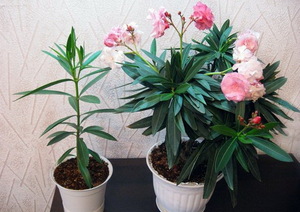 In nature, oleander forms naturally in the form of a tall shrub with branches sticking out chaotically in all directions. At home, for an aesthetic purpose, they give it a beautiful tree-like shape, not allowing it to grow chaotically in all directions. For this purpose, in young plants, the basal lateral shoots are annually cut off, leaving only the central tree-like trunk.
In nature, oleander forms naturally in the form of a tall shrub with branches sticking out chaotically in all directions. At home, for an aesthetic purpose, they give it a beautiful tree-like shape, not allowing it to grow chaotically in all directions. For this purpose, in young plants, the basal lateral shoots are annually cut off, leaving only the central tree-like trunk.
In oleander, pruning and shaping is done with garden shears and pruning shears. It is imperative to observe safety precautions, work in rubber gloves, a special mask and goggles, carefully making sure that the plant sap does not get on the skin surfaces or mucous membranes.
Crop care at home
The splendor and duration of flowering is in direct proportion to the observance of agricultural cultivation techniques. Oleander is a representative of the tropical flora, it needs to create a microclimate close to its natural habitat. If you do not take care of it, the tree or bush will lose its decorative effect. For example, despite the love of the bright sun, direct rays can cause burns on delicate shoots.
It is important to adhere to the tips and recommendations for the cultivation of exotic plants in indoor conditions.
Location and lighting
Oleander loves a lot of daylight. It is not dangerous to place it on the southern windowsills, where it is practically not exposed to the negative effects of sunlight. Only on the hottest days is it recommended to shade the windowsill in the midday heat. Oleander also grows well near east-facing windows. But when placed on the western and northern windowsills, the plant is provided with additional lighting using a phytolamp. In the summer, if there is a possibility, it is better to take the container with a flower to the terrace or garden, organizing an additional shelter from atmospheric precipitation.
For your information! Due to the intense aroma, the flower pot is installed in spacious foyers, since the pungent smell can be overwhelming in an enclosed space, causing dizziness and insomnia.
Temperature regime
For an oleander in a private house, if there is a veranda, it is not difficult to provide comfortable maintenance. But in the apartment in the winter, difficulties may arise. The optimal temperature regime for summer is 22-25 ° C, and for winter - 10-15. The critical value on a mercury thermometer is 5 ° C. In addition, care must be taken that there are no sudden changes in daily temperatures, which have a detrimental effect on the decorative effect and immunity of the plant.
Watering
Moistening oleander is an important agrotechnical measure. Frequency and volume depend on the season
During the period of active growth, which occurs in spring and summer, the plant is often watered, preventing the earthen coma from drying out. Closer to winter, irrigation is reduced, since excess moisture can cause the development of root rot. An abundance of liquid at low temperatures can also provoke the death of a flower. Water the oleander only with warm water, previously settled.
Bathing and spraying

"Native" from the tropics loves high humidity. Regular spraying, which is carried out twice a day during a hot period, helps to ensure it. A contrast shower helps to keep the crown clean, as well as protect it from damage by aphids and spider mites. Such measures allow to timely clean the shoots from pollution, freely "breathe" them and saturate the air in the room with oxygen.
Top dressing and fertilizers
Mineral complexes are used to enrich the substrate. After planting or transplanting, the first top dressing is carried out only two months later, when the nutritional value of the soil becomes lower. In the future, fertilizers are applied to the soil mixture every two weeks, but only during the active growing season. In the stagnation stage, additional nutrition is not required for the bush.
Pruning and shaping oleander
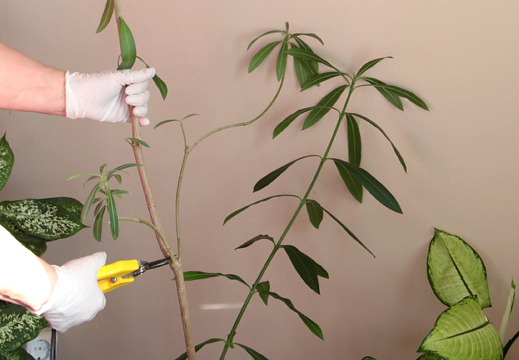
The plant has a fast growth rate. If you do not limit the development of shoots, then in several years they will exceed 2-3 m. In autumn, the stems are shortened in order to form a dense and compact crown, which provides a high decorative effect to the shrub. In the spring, as a rule, damaged, diseased and fluttering shoots are cut off (sanitary haircut).
Post-flowering care
Inflorescences bloom only on young branches. Shoots developing under the flower buds are removed. If this is not done, the growth of the entire bush will slow down. To extend the flowering period, it is recommended to prune withered flowers. However, this should be done carefully, without damaging the adjacent groups of buds. Otherwise, the latter will no longer form.
Dormant period
Since in the natural environment the plant develops with seasonal changes in temperature regime, then at home it also needs to organize the stage of stagnation. The optimum temperature range is about 12 ° C. At this time, watering is carried out extremely rarely, only when the earthen coma dries out, top dressing is completely excluded. But the flower needs light - at least 10 hours a day.
For information! If the flower does not plunge into the stage of stagnation, there is a high risk that the owner of the oleander will not see the flowering in the next season.
Types and varieties
Blooming oleander fascinates with its beauty and aroma. Vacationers at the resorts of Crimea remember its smell for a long time. In many perfumes, notes of nerium oleander are guessed.
Additional Information. The noble flower has become a symbol of the city of Yalta.
Breeders have developed many beautiful new hybrid varieties with flowers of different shapes and colors.
White
It has large flowers, simple or double, collected in corymbose inflorescences. White oleander has a strong caramel smell. They love to grow it in office buildings.
White flower
It is believed that the plant relieves bad mood and improves performance.
Pink terry
Its velvety flowers are like small roses with a delicate delicate scent. Terry pink oleander enchants with its beauty, blooms until late autumn. By pruning, they give it the most varied shape.

Pink terry
Yellow
Large bright yellow flowers are partly reminiscent of bells. It is a hardy drought-resistant plant. Well tolerates light frosts, suitable for growing on balconies. In warm weather, yellow oleander in containers decorates the site beautifully.

Yellow flower
Indian
It can grow up to 4 m in height. It has lush racemose inflorescences. The flowers are large: red, pink, yellow, white with a sweet smell. Blooms until late autumn.
Fragrant
This variety grows up to 50 cm. It is famous for its excellent aroma.
Additional Information. Oleander was the first flower to bloom in the radiation-contaminated lands of Hiroshima. It was a real miracle for the Japanese.
General description of oleander
Oleander (Nerium) belongs to the genus of evergreen shrubs of the Apocynaceae family. The only representative of this genus - Oleander ordinary (Nerium oleander) grows in North Africa, in the Mediterranean countries, in Southeast Asia, India and Japan. In our country, in the Crimea and on the Black Sea coast of the Caucasus, you can find whole thickets of this plant.
Species diversity
In the wild, it reaches a height of three to four meters. In indoor conditions, it grows up to two meters. The stem is erect, brownish in color with small outgrowths. The leaves are lance-shaped, bright green in color, with characteristic sharp points at the ends. Due to the external similarity of the shape of the leaves, oleander is sometimes called "pink laurel", although in fact, of course, it is not any laurel.
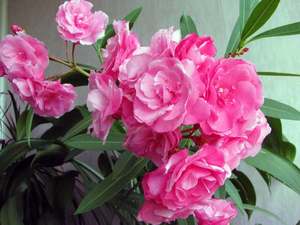 Thanks to breeding work, a large number of varieties of common oleander have been bred, characterized by a variety of colors, shapes and sizes of flowers. Distinguish between small, large, smooth and double flowers. The color scheme is presented in red, white, yellow and pink colors. The intensity of the color can vary and several shades can be combined on one plant at the same time. In oleander, the flower is characterized by a pleasant and intense aroma, this scent can be so strong that it can cause severe headaches.
Thanks to breeding work, a large number of varieties of common oleander have been bred, characterized by a variety of colors, shapes and sizes of flowers. Distinguish between small, large, smooth and double flowers. The color scheme is presented in red, white, yellow and pink colors. The intensity of the color can vary and several shades can be combined on one plant at the same time. In oleander, the flower is characterized by a pleasant and intense aroma, this scent can be so strong that it can cause severe headaches.
Signs of poisoning
Oleander can be called a plant with a surprise. And if you do not know all of its physiological characteristics, then this surprise will turn out to be extremely unpleasant and even deadly for those who try to cultivate it at home. The fact is that common oleander is very poisonous.
When asked why it is poisonous, the answer is very simple: the fact is that almost all of its tissues contain cardiac glucosides, substances that, in small doses, stimulate the work of the heart muscle. An overdose of these substances leads to disruption of electrical conduction in the heart muscle and heart rhythm, which ultimately leads to cardiac arrest.
The characteristic signs of oleander poisoning appear a few hours after the poison enters the bloodstream:
- Abdominal pain.
- Nausea and vomiting.
- Diarrhea (diarrhea) with blood.
- Tachycardia (increased heart rate).
- Constriction of the pupils.
- Drop in pressure.
- Heart failure.
Rules for planting and growing perennial daisies
Precautionary measures
Before deciding to grow it in an apartment, you need to make sure that you have the necessary conditions for this. It is extremely dangerous to do this if there are small children and pets in the house. The main security measures are as follows:
- You can not place this plant in the bedroom and small rooms. Oleander is a plant for large rooms and spacious halls. Otherwise, the strong scent of its flowers will cause headaches.
- It is necessary to exclude access to the plant for children and pets.
- All work with the plant must be carried out in rubber gloves and a protective mask.
- Avoid getting the juice of the plant on open areas of the body and especially in the eyes. Eye contact with oleander juice can cause loss of vision.
And in all other respects, it is an excellent plant for growing at home, which is a pleasure to take care of. As numerous fans of this home giant say: the oleander is strong, beautiful and noble.
Diseases and pests
Some of the most common oleander pests include:
- Shield. To destroy it, you should use a special insecticide.
- Aphid. To save the plant from this unpleasant insect, it is enough to wipe the leaves with a solution of ordinary laundry soap. Tar soap, which is often found in many homes, is also suitable.
- Spider mite. To get rid of it (if the situation is not started) is quite simple: you should wipe the affected areas with a cotton pad dipped in alcohol, and then with clean water.
Sometimes, growths may appear on the leaves that resemble cauliflower in appearance. These are signs of oleander cancer, the affected areas should be removed immediately. If the disease has spread, the plant should be destroyed, keeping it close to others means spreading the infection throughout the house.
In insufficient light, the leaves of the plant may turn yellow. What reasons can cause the lack of flowering? There are several of them:
- insufficient lighting in the house;
- poor organization of watering;
- not performed trimming and pinching;
- lack or inadequacy of feeding;
- very large pot.
How to plant an oleander?
The flower is propagated by seeds and cuttings. It is easier to use rooted cuttings, since it is difficult to germinate seeds at home - seedlings require maintaining a constant temperature and additional lighting. For planting by cuttings, branches from pruning are suitable. Planting oleander is best planned at the end of spring.
When planting seeds, provide special conditions:
- diffused light, preferably sunlight;
- humidity from 80 to 100%;
- temperature + 220C.
Sowing soil should include equal parts of peat, turf and perlite. The seeds are lightly pressed into the ground and do not sprinkle, as they need sunlight. The seeds will not germinate at the same time, it may take one or three months. When at least two leaves are formed on the seedlings, they are transferred to the soil for adult flowers and then care for them becomes common, even planting in open ground is possible.
When propagating by cuttings, you need to select semi-lignified branches of 15 cm, which should be cut with a sharp knife in order to preserve the structure on the cut.Leave only the top three leaves on the handle and cut off their tips. Process the cut and 2 cm of the cutting with Kornevin or
Heteroauxin and place in water, providing:
- the water temperature is from 200C to 270C, the evaporated water must be topped up with new;
- bright diffused light.
When the roots grow up to 3 cm, you can plant the cuttings in a mixture of sod and leafy soil and perlite (1: 1: 1).
Seedling care
In the first month, provide the seedlings with diffused but bright light, later move the flower closer to the sun. Top dressing begins from the second month, before this fertilizer must be diluted to half the recommended concentration. From the third month, the plant is considered an adult, and care becomes common.
To root the cuttings in the soil, make holes for drainage in celluloid cups, pour in the substrate (equal parts of peat and perlite) and moisten it. Dip the stalk treated with the stimulant into the hole and squeeze the soil around with your fingers. With this method of breeding, almost 100% humidity is required, so arrange a small greenhouse. Keep the substrate moist and ventilate the greenhouse every day
Terms and rules for pruning oleander
The main purpose of pruning oleander is to form a tree with a beautiful crown from a shrub. Oleander pruning is carried out 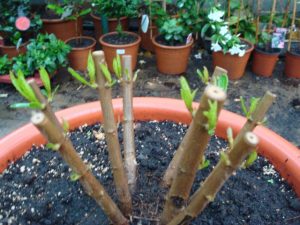 in the fall, around the end of August each year, cutting off the branches by half or more. On adult plants, you need to cut off all long branches, so that later in their place several shoots appear, the ends of which will become overgrown with inflorescences by the due date. When pruning oleander, you should not remove wilted inflorescences, because in the spring they can bloom again. Oleander buds have been forming since last year, so there is no point in pruning them in the spring. Pruned branches may be suitable for breeding oleander. Cuttings that are rooted and growing should also be plucked to speed up the branching process.
in the fall, around the end of August each year, cutting off the branches by half or more. On adult plants, you need to cut off all long branches, so that later in their place several shoots appear, the ends of which will become overgrown with inflorescences by the due date. When pruning oleander, you should not remove wilted inflorescences, because in the spring they can bloom again. Oleander buds have been forming since last year, so there is no point in pruning them in the spring. Pruned branches may be suitable for breeding oleander. Cuttings that are rooted and growing should also be plucked to speed up the branching process.
Precautions when pruning oleander
In principle, the oleander may not be cut, but then it will acquire its natural form of a bush without a large thick trunk. When the gardener for some reason did not cut the shoots and the branches grew too long, they will have to be tied to supports, which is not very convenient. Therefore, you should always prune the plant on time. The procedure for pruning a plant should be carried out very carefully: oleander is a poisonous plant, it contains oleanin - a deadly poison that can cause colic and a malfunction of the heart in a person, so the gardener should wear gloves and thoroughly rinse the scissors or pruning shears after pruning the plant. Also, some of the toxic substances are released into the air, so it is not recommended to keep oleander in the bedroom or in other small and poorly ventilated rooms.
Re-pruning the shrub
Many breeders note that it is necessary to prune the oleander not only in the fall, after the shrub has bloomed, but also in the spring. Before the growing season, small shoots are removed at the root, and larger ones are cut by about 2/3. This procedure will improve the growth of young shoots, so that flower buds will be laid in their place. It is better to carry out spring pruning in March or April, after the daylight hours have lengthened.
It is also important to remember that an adult plant should be replanted once every two or three years, and young shrubs every year.
In large tub oleanders, during transplantation, according to gardeners, fragments of the root system can be removed, which will have a beneficial effect on the plant.
Oleander (Nerium) is an evergreen shrub from the Kutrovy family. The plant appeared in the subtropics of the Mediterranean. Its close relatives are herbaceous plants, parasitic vines and giant tropical trees. In the wild, it occurs in the form of tall (up to 4 m) powerful bushes in the river valleys of Asia Minor, in the Caucasus mountains, grows in Algeria and Italy.There is only one cultivated form of this plant, and they call it - "ordinary" oleander! In the open field, oleander is grown and used in landscape design on the Black Sea coast and in the Crimea.
In areas located to the north, the plant is bred in greenhouses and at home. Oleander grows rapidly, growing by 30 cm per year. At home, it can grow more than 2 meters, if you do not limit the growth by pruning. Usually lives in an apartment up to 15 years, but if the bush is rejuvenated and properly looked after, it can live longer. Flowering lasts from July to October. On the shoots, large bright flowers coexist with unopened buds, so it seems that the oleander blooms constantly.
| It grows quickly, up to 30 cm per year. | |
| Blooms from mid-summer to mid-autumn. | |
| The plant is easy to grow. | |
| Perennial. |
ROSE MEDITERRANEAN - OLEANDER IN MY GARDEN

Oleander photo
This beautiful tree with fragrant flowers has always attracted my attention. Before purchasing a seedling, I studied its features
It turns out that all parts of the bush are poisonous. But this did not stop me, because many ornamental plants contain substances that are dangerous to humans and animals.
It's just worth taking precautions when working with them.
I got a blooming pink terry oleander in a container on the market. He grew in one tall, almost 1 m, stem. “You will cut and form a neat bush,” the seller advised.
Oleander. Reproduction, planting, care features
First cut
After flowering, I cut off (you need to work with gloves!) The shoot at an oblique angle, leaving one third of the height. In the fall, three new branches appeared on the bush, each of which gave a peduncle by the next summer.
Experiments with oleander cuttings
I tried to root the cut branches in a mixture of peat and perlite (1: 1). Of the three, only one survived and bloomed the next spring. I also pruned this young oleander after flowering, and rooted the cuttings in settled water with activated carbon tablets. This method turned out to be optimal. The roots grow powerful, the seedlings take root well in the open field.
Oleander care secrets
Now my first oleander is 5 years old. For two years I do not cut it cardinally, so the plant has time to bloom again. I carry out only corrective pruning, rooting side shoots.
I prepare the soil for cuttings as follows: I mix soil for flower plants, special for azaleas, coconut fiber (2: 1: 1.2), adding a handful of vermiculite.
For the summer, I plant the grown handsome men in open ground among roses and lilies (adult specimens can simply be dug along with the container). I choose sunny places for them.
I feed during the budding period with potassium fertilizer (according to the instructions). I also put a handful of ash under each bush and mulch with a small amount of compost so that it covers the soil around the plants.
For wintering
In September, I carefully transfer the plants into containers and bring them into the house. At the end of winter, they already bloom. The rose of the Mediterranean, as oleander is often called, does not like dry air, so I constantly spray the bushes, and I keep the flowerpots in a pallet with moistened expanded clay. Sometimes I bathe in the shower.
I feed with complex fertilizers for flower plants.
Oleander blooms like a king
Oleander has been living with me for several years. I grew a tree from a cutting. It should be noted that even in a non-flowering state, the plant formed by regular pruning looks decorative, and during the flowering period it looks like a king.
The first two years I formed the crown of the oleander, so the buds appeared only in the third year. But my joy was short-lived. The fact is that the oleander spent the summer on an open balcony with a western orientation.
I noticed the buds in mid-July, but the August cold snaps and temperature drops did their job: the buds fell off without opening. A similar situation was repeated the next year.But then the opportunity arose for the summer to identify the oleander on the glazed southern balcony, and the plant delighted with fragrant flower caps.
In general, caring for oleander is simple: from about mid-April to the first autumn frosts, the plant spends on the balcony. In the spring and summer, the tree has to be watered daily. With each watering, I add a small amount of fertilizer for flowering plants to the water. In September, after flowering, I reduce watering, do not feed. In mid-November, I bring oleander into the house, it hibernates near the balcony door, while trying to keep the window on micro-ventilation.
I read different things about pruning: some recommend carrying it out after flowering in the fall, others in the spring, before the start of active growth.
The second option is more suitable for me (I shorten the branches by 2/3), since in winter, with a lack of light and a relatively warm content, oleander can begin to grow and young branches will stretch out. If you cut it in the spring, then new branches grow in good lighting, already on the balcony, which cannot but affect their appearance.
Nursing and growing at home
If you pay close attention to the oleander and take a responsible approach to caring for it, then the plant can grow up to two meters in height.
Therefore, it is important to prepare the right place for the bush in advance. Given some of the features of this plant
Location and lighting
- Well lit place. The bush will be large and lush only if it receives a lot of light.
- If it stands near the north window, then it must be additionally illuminated with the help of fluorescent lamps.
- With a lack of light, the foliage of the plant begins to crumble.
- In the hot season, the flower should stand in a well-lit and ventilated place.
- A newly purchased flower must be accustomed to the direct rays of the sun gradually.
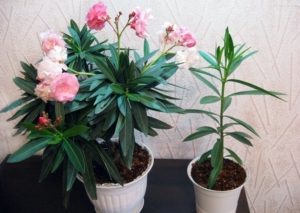
At home, during flowering, you can put a flower on a balcony or veranda.
Keep the plant away from children and animals, as it contains poisonous substances in all its parts. Even a small bite from it can cause serious stomach upset in a baby or animal.
Temperature
The room with the plant must be well ventilated.
Temperatures in spring and summer range from 20C to 28C.
In autumn - no more than 18C.
In winter - from 8C to 15C.
With the onset of March, it is important to gradually increase the temperature in the room where the plant is located.
Watering
Use water at room temperature, it is better if it settles for a day before that.
Spring and summer: water when the topsoil dries out.
On hot days, the water flowing into the pan is left, and on cool days it is poured out.
In autumn and winter: after the top layer of the soil mixture dries out, only after two days can watering be carried out again
But the clod of earth should not be allowed to dry out, it is important to monitor this.
Bathing and spraying
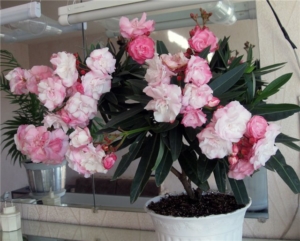
- In summer, the plant does not need additional moisture. At very high temperatures, water is poured into the pan, this is enough.
- In winter, when the room is heated, the air is hot and dry, you should additionally spray the plant with water at room temperature.
In winter, the ends of the leaves may dry out, so the flower should be sprayed constantly.
Top dressing
Fertilization of the plant is carried out in the spring-summer period every 2 weeks. This is best done in cool weather. Top dressing consists of complex fertilizers suitable for indoor plants. Both mineral and organic fertilizers are excellent, so it is better to use them alternately.
Pruning and shaping the crown
Reference. Regular pruning of the oleander is necessary, otherwise the plant may not start blooming.
- A young plant will branch well and bloom more profusely.
- By pruning, you will form a beautiful crown of the flower and will be able to adjust its height.
- It is carried out immediately after flowering.
- The branches are shortened by half or 2/3 parts.
- The cut pieces can be used as cuttings.
- Vegetative shoots growing under the buds of flowers must be removed, they slow down the growth of the plant.
- Pruning should be done with gloves, since the plant is poisonous.
What to do when bloomed?
Oleander flowers open between June and October. During this period, you also need to remember to take care of the plant.
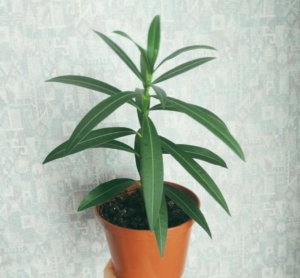
- Be sure to remove vegetative shoots growing under flower buds. They prevent the plant from developing and slow down its growth.
- Those flowers and leaves that have already wilted should also be removed. Do this very carefully, try not to damage the inflorescences that new flowers can give.
- After all the inflorescence has faded, it is completely cut off with a secateurs.
- After flowering, the oleander must be pruned.
Dormant period
When the time approaches winter, the shrubs need special care and increased attention.
- From November to February, the oleander needs to be as quiet as possible. It should be in a cool, bright place. Room temperature from 12C to 15C.
- Be sure to arrange additional artificial lighting up to 10 hours a day.
- Do not overflow the plant when watering and avoid acidification of the soil. Otherwise, the root system of the flower will rot.
Attention. If the conditions are not met, the flower may shed its leaves and not bloom next time.
Transfer to the ground
First, prepare a suitable substrate. You can use a ready-made store-bought mixture or make the soil yourself by mixing the following components in equal parts:
- humus;
- turf;
- peat;
- sand.
Be sure to disinfect the substrate before planting so that the plants do not suffer from pathogenic microbes and pests that live in the soil. For disinfection, hold the mixture over steam, bake in the oven or spill with potassium permanganate.
As for the pot, for young oleanders it is better to choose small flowerpots, the diameter of which is 3-5 cm larger than the root flower system. Otherwise, the plants will not release buds for a long time. And also give preference to pots that have a height greater than a width.
The landing itself is carried out according to the following algorithm:
At the bottom of the pot, pour a layer of brick chips or expanded clay drainage. Sprinkle it lightly with the substrate
Place the plant carefully in the center of the flowerpot. If you dive oleanders after growing from seeds, then plant them together with an earthen clod
Fill the voids with soil, slightly compacting the soil. To do this, gently knock on the sides of the pot. Please note that the root collar of the flower should be flush with the ground. Pour warm water over the soil and place the pot in its usual place.
Carry out the first feeding only two months after planting. And for the next two months, use only half of the recommended fertilizer dose. The rest of the care for seedlings is the same as for adult plants.
Home care
An abundance of sunlight is needed for good growth and development. Not afraid of sunlight and feels great on the south side.
Summer temperature should be + 21- + 27 degrees. In winter, it is in a dormant period and is kept at a lower temperature. Needs fresh air and is not afraid of drafts. In summer can be placed on the balcony.
Infrequent but abundant watering is required. Excess moisture can lead to flower disease. Doesn't need high humidity. In summer, it can be sprayed occasionally.
For irrigation, settled water is used; it contains less chlorine and harmful salts.
During the flowering period, the plant is fertilized with a complex for flowering indoor plants. Fertilizer is applied once every 3-4 weeks. It is necessary to alternate between mineral and organic complexes. In winter, the plant does not need to be fertilized to maintain a dormant period.
Oleander needs pinching and pruning. This allows you to maintain a lush flowering and decorative effect.To keep the flowers on the oleander large, the vegetative shoots are systematically pinched. Pruning is carried out in the fall. The plant is cut by 2/3.
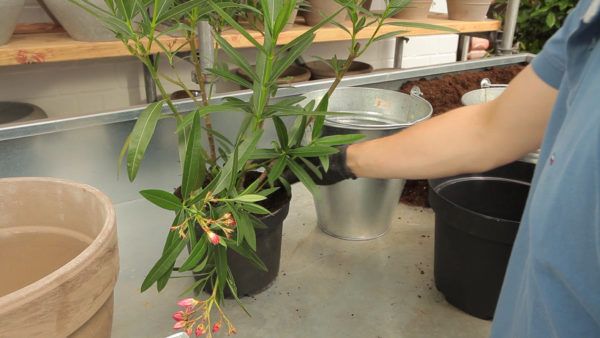 Oleander needs a transplant
Oleander needs a transplant
In addition, the oleander needs a transplant. Young plants need an annual transplant, adults are transplanted once every 3 years. It is necessary to keep an earthen ball when transplanting. The transshipment is optimal for oleander.

